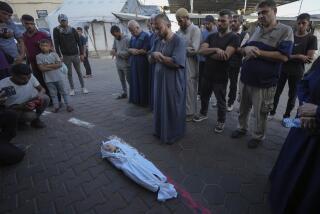U.S. report on Afghan hospital attack ‘shocking,’ medical group says
Reporting from Washington — The top U.S. commander in Afghanistan said Wednesday that multiple service members were suspended from duty following an investigation into the deadly airstrike last month on a hospital in Kunduz.
Gen. John F. Campbell said the Oct. 3 strike on a Doctors Without Borders hospital, which killed 30 civilians and left 37 others wounded, was “tragic, but avoidable.” Human errors compounded by technical malfunctions onboard the AC-130 attack aircraft caused the strike, he said, speaking to reporters at the Pentagon in a video broadcast from Kabul, Afghanistan’s capital.
The investigation found that the “cause of this tragedy was … avoidable human error, compounded by process and equipment failures,” Campbell said.
The medical facility was misidentified as a target by U.S. military personnel who believed they were striking a different building several hundred meters away where there were reports of Taliban fighters, he said. The hospital was on the military’s so-called “no-strike list.”
Campbell did not identify the names or number of individuals suspended and did not say whether they would face disciplinary or criminal charges. Decisions on whether to prosecute will be made by the U.S. Special Operations Command, officials said.
“The cornerstone of our military justice system is the independence of decision-makers following a thorough investigation such as this one,” Campbell said. “We will study what went wrong and take the right steps to prevent it in the future.”
According to the military’s investigation, the special operations gunship had sought to attack a building suspected of being used as a base by Taliban insurgents, but the plane’s onboard targeting system identified the coordinates as an open field. The crew decided to open fire on a nearby large building, not knowing that it was the Doctors Without Borders hospital.
Because the gunship had been diverted from another mission, the crew had not been briefed on the location of the hospital.
No U.S. military personnel were in visual range of the hospital when Afghan forces, claiming they were under fire, requested the airstrike, the report said.
The summary did not answer all the questions about what went wrong, including whether the errors identified in the report constitute war crimes or why the crew opened fire when it appears they had reason to be uncertain about the target. Campbell did not take questions from reporters after his statement.
Doctors Without Borders, which had previously said the attack likely was a war crime, released a statement saying the report left “more questions than answers.”
“It is shocking that an attack can be carried out when U.S. forces have neither eyes on a target nor access to a no-strike list and have malfunctioning communications systems,” said the statement from the group, also known as MSF, its French acronym.
“It appears that 30 people were killed and hundreds of thousands of people are denied life-saving care in Kunduz simply because the MSF hospital was the closest large building to an open field and ‘roughly matched’ a description of an intended target,” the statement said.
“The frightening catalogue of errors outlined today illustrates gross negligence on the part of U.S. forces and violations of the rules of war,” the group said, repeating its call for an “independent and impartial investigation.”
The attack came as American warplanes and ground forces, including an undisclosed number of special operations troops, were assisting an Afghan operation to retake Kunduz, in northern Afghanistan, which had fallen to the Taliban in late September.
After five days of fighting, U.S. special operations and their Afghan counterparts had moved into the compound of the provincial chief of police. On Oct. 2, the Afghan military asked an unnamed U.S. special operations commander for air support that night as they cleared a building once used by the Afghan intelligence service that they believed was controlled by Taliban. The American commander promised to have aircraft on standby, Campbell said.
When Afghan troops called for help later that night, the U.S. commander called in an AC-130 aircraft and provided the proper coordinates of the intelligence service building, Campbell said.
But when the air crew put that location into its onboard targeting system, it showed a open field more than 300 yards from the building.
The aircraft was more than eight miles from the target area, a precaution the crew had taken because they thought a missile had been fired at them from the ground, Campbell said. But the distance “degraded the accuracy” of the targeting equipment.
The crew “visually located” the largest building near the open field, which was the hospital, he said.
“This misidentification continued throughout the remainder of the operation, even though there were some contradictory indicators,” Campbell said.
When the gunship flew closer, its targeting system “correctly aligned” with the intelligence building, not the hospital, but the crew ignored the system, he said.
The AC-130 aircraft had launched more than an hour early “without conducting a normal mission brief” or receiving a list of locations that it was barred from attacking, including the hospital, he said.
Doctors Without Borders had reminded the U.S. military of the precise coordinates of the hospital multiple times in the days before the airstrike, a warning acknowledged in the military investigation.
A minute before the gunship started firing, the crew transmitted the coordinates of their target to their headquarters at Bagram Airfield, north of Kabul, giving the accurate location of the hospital, Campbell said.
The headquarters “did not realize that the grid coordinates for the target matched a location on the no-strike list,” he said.
Just after 2 a.m. Oct. 3, the crew opened fire on the hospital, even though they “did not observe” a firefight under way, the original reason for the airstrike, he said.
The aircraft made multiple passes over the hospital, the largest building in a compound containing half a dozen other structures, firing heavy munitions that left the hospital in flames. In several cases, people running from the building were gunned down, according to Doctors Without Borders.
The U.S. commander in Kunduz, who was not identified, remained at the police compound during the strike and was not within “visual range” of the hospital or the intelligence building, Campbell said.
“Under the circumstances, the U.S. [special operations force ] commander lacked the authority to direct the aircrew to engage the facility” and was “unable to adequately distinguish” between the hospital and the intelligence building, Campbell said.
Doctors Without Borders called U.S. military personnel at Bagram at 2:20 a.m. to tell them the hospital was under attack. But it wasn’t until 17 minutes later – when the AC-130 had already stopped firing -- that the U.S. special operations commander realized the fatal mistake, Campbell said.
The attack destroyed the main hospital building, where medical personnel were catching up on a backlog of surgeries, taking advantage of the first quiet night since Taliban forces seized control of Kunduz five days earlier.
For more on the Pentagon and U.S. military policy, follow @WJHenn
ALSO
South Africa’s guru for benefits of saturated fat faces hearing
Russia deploys missiles in Syria; pilot denies straying into Turkish airspace
Pope Francis calls for unity, links terror to poverty as he launches Africa tour
More to Read
Sign up for Essential California
The most important California stories and recommendations in your inbox every morning.
You may occasionally receive promotional content from the Los Angeles Times.












